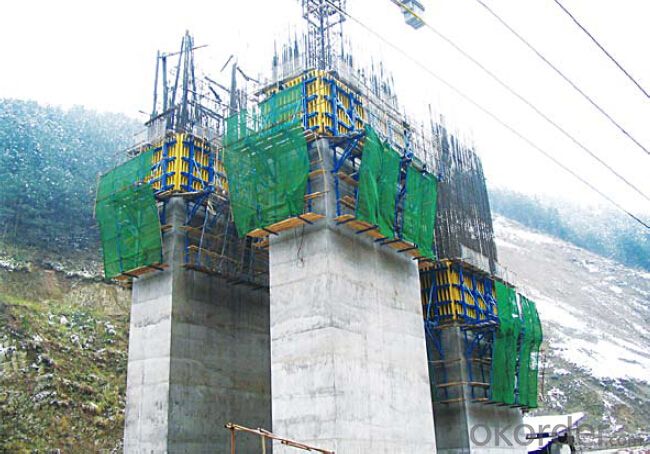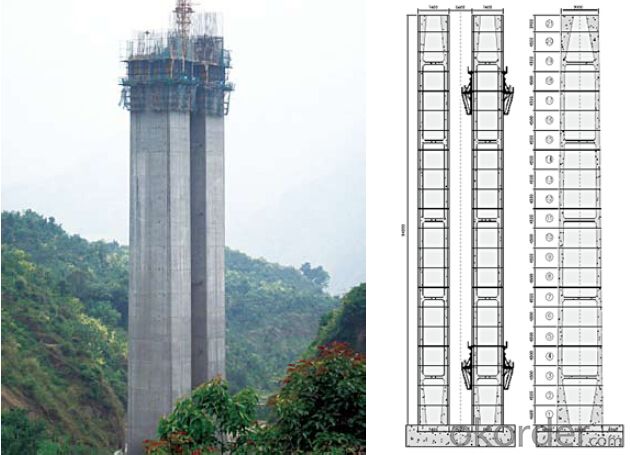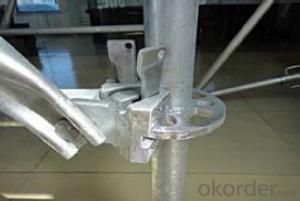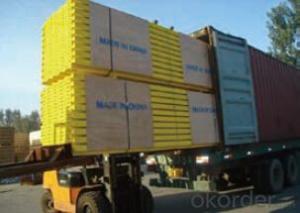Climbing Bracket CB240 for Formwork And Scaffolding Systems
- Loading Port:
- Tianjin
- Payment Terms:
- TT OR LC
- Min Order Qty:
- 50 m²
- Supply Capability:
- 1000 m²/month
OKorder Service Pledge
OKorder Financial Service
You Might Also Like
Climbing Bracket CB240 & CB210
They are framework brackets for supporting large-area wall formwork.
Typical applications for the CB240&CB210 are pier and column/shear wall/core walll/ in the
building.
CB210 has smaller size than CB240, it will be cost effective in some condition.
Characteristics:
◆ High bearing capacity
The high loading capacity of the brackets allow very large scaffold units. This saves the number
anchor points required as well as reducing climbing times.
◆ Simple moving procedure by crane
Through the strong connection of formwork together with the climbing scaffold, both can be moved
as a single climbing unit by crane. Thus valuable time-savings can be achieved.
◆ Fast striking process without a crane
With the retrusive set, large formwork elements can also be retracted quickly and a minimum of
effort.
◆ Safe with work platform
The platforms have assembled firmly with bracket and will be climbing together, without scaffolding
but can work safely in spite of your high location.
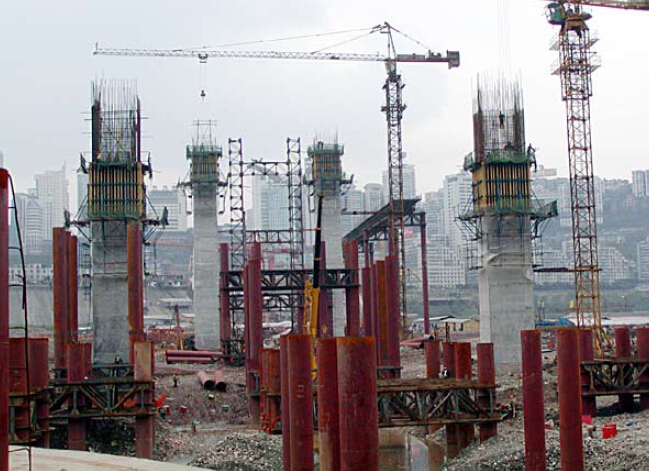
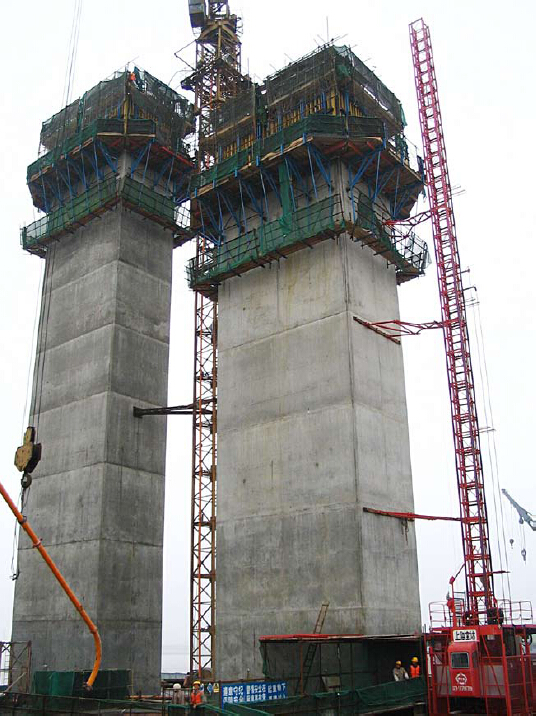
- Q: Can steel formwork be used for both horizontal and vertical concrete placements?
- Yes, steel formwork can be used for both horizontal and vertical concrete placements. Steel formwork provides a strong and durable structure that can withstand the pressure exerted by concrete during pouring and curing processes. It is versatile and can be easily assembled and disassembled, making it suitable for various construction applications.
- Q: Can steel formwork be used for curved structures?
- Yes, steel formwork can be used for curved structures. Steel is a versatile and strong material that can be easily shaped and fabricated to create various forms, including curved structures. With the help of advanced technologies such as computer-aided design (CAD) and computer-aided manufacturing (CAM), steel formwork can be custom-made to meet the specific requirements of curved structures. This allows for greater flexibility and creativity in architectural design, enabling engineers and architects to create unique and visually appealing curved structures. Additionally, steel formwork offers several advantages such as durability, reusability, and high load-bearing capacity, making it a suitable choice for constructing curved structures that require structural strength and stability.
- Q: Can steel formwork be used for curved or complex structures?
- Indeed, curved or intricate structures can be constructed using steel formwork. The employment of steel formwork provides abundant flexibility and adaptability, rendering it well-suited for fashioning diverse shapes and designs. Its robustness and sturdiness enable it to maintain its form, even when employed in curvilinear or intricate structures. Moreover, steel formwork can be conveniently fabricated and modified to meet particular project specifications, rendering it a perfect selection for erecting complex designs.
- Q: Can steel formwork be used in residential housing projects?
- Yes, steel formwork can be used in residential housing projects. Steel formwork is a versatile and durable option for construction, offering strength and stability to the structure. It allows for precise and efficient shaping of concrete, ensuring high-quality finishes in residential buildings. Additionally, steel formwork can be reused multiple times, making it a cost-effective choice for long-term projects.
- Q: What are the different sizes and dimensions available for steel formwork panels?
- Different construction needs can be accommodated with steel formwork panels that come in various sizes and dimensions. The construction industry widely utilizes steel formwork panels measuring 1.2 meters by 2.4 meters and 1.5 meters by 3 meters due to their versatility and efficiency. The load-bearing capacity and durability of steel formwork panels determine their thickness, which typically ranges from 12mm to 18mm. Heavy-duty applications often require thicker panels, while lighter loads can be supported by thinner panels. Aside from the standard sizes, custom sizes and dimensions can be produced to fulfill specific project requirements. This flexibility enables contractors to tailor the formwork panels to their unique construction needs, ensuring optimal performance and efficiency on-site. It is important to acknowledge that the sizes and dimensions of steel formwork panels may differ among manufacturers. Therefore, consulting with the supplier or manufacturer is crucial to determine the available sizes and dimensions for a particular product line. This step guarantees that the chosen steel formwork panels are suitable for the intended application and meet the necessary structural requirements.
- Q: How does steel formwork handle different concrete bleeding rates?
- Steel formwork is a versatile and strong material that can effectively handle different concrete bleeding rates. Concrete bleeding refers to the process where water in the concrete mixture rises to the surface, leaving behind a layer of excess water. This excess water can cause various issues during the curing process, such as reduced strength, increased porosity, and surface defects. Steel formwork is typically designed with tight joints and a smooth surface, which helps to minimize the bleeding of concrete. The tight joints prevent excessive water from escaping through the formwork, while the smooth surface allows for easy removal of any excess water that does bleed out. This helps in maintaining the desired water-cement ratio and ensures proper hydration and curing of the concrete. Additionally, steel formwork is a rigid and sturdy material that can withstand the pressure exerted by the concrete during the pouring and curing stages. This strength allows the formwork to maintain its shape and prevent any bulging or deformation caused by the bleeding of concrete. In cases where the concrete has a high bleeding rate, steel formwork can be further reinforced with additional support systems such as braces or tie rods. These reinforcements help to strengthen the formwork and ensure that it can withstand the increased pressure caused by excessive bleeding. Furthermore, steel formwork can be easily cleaned and reused for multiple projects. This means that any excess water or bleeding from previous concrete pours can be effectively removed, allowing for a fresh and clean surface for the next pour. In conclusion, steel formwork is well-equipped to handle different concrete bleeding rates. Its tight joints, smooth surface, strength, and ability to be reinforced make it an ideal choice for managing bleeding in concrete construction projects.
- Q: What are the different types of steel formwork ties and connectors?
- There are several different types of steel formwork ties and connectors used in construction projects. These ties and connectors are essential for securing and connecting formwork panels, ensuring the stability and strength of the concrete structure being built. 1. Snap Ties: Snap ties are one of the most commonly used types of formwork ties. They consist of two parts - a metal rod and a flat metal plate. The rod is inserted through the formwork panels and then snapped onto the plate, holding the panels securely in place. 2. Wedge Ties: Wedge ties are another popular formwork tie option. They consist of a metal rod with a wedge-shaped end and a flat metal plate. The rod is inserted through the formwork panels, and the wedge is driven into a slot on the rod, creating a tight connection between the panels. 3. Loop Ties: Loop ties are commonly used in situations where the formwork panels need to be easily adjustable or repositioned. They consist of a metal rod with a loop at one end and a flat metal plate at the other. The loop is inserted through the formwork panels, and the rod is bent to secure the panels together. 4. Flat Ties: Flat ties are similar to snap ties but do not have a snap mechanism. They are made of a flat metal plate with holes for inserting a metal rod. The rod is inserted through the formwork panels, and the flat tie is secured by twisting the rod or using a locking device. 5. Tie Rods: Tie rods are used in conjunction with various formwork ties to provide additional strength and stability. They are long steel rods that are inserted through the formwork panels and secured with nuts and washers on both ends. 6. Formwork Clamps: Formwork clamps are connectors used to join and align formwork panels. They are typically made of steel and have adjustable screws or bolts to tighten and secure the panels together. 7. Combi Nuts: Combi nuts are used in combination with tie rods and formwork clamps to connect and tighten formwork panels. They have a threaded hole that allows the tie rod to pass through and secure the panels. These are some of the common types of steel formwork ties and connectors used in construction projects. The selection of the appropriate type depends on factors such as the formwork system being used, the load requirements, and the specific needs of the project.
- Q: Can steel formwork be used in earthquake-prone areas?
- Yes, steel formwork can be used in earthquake-prone areas. Steel is a strong and durable material that can withstand the forces exerted during an earthquake. It has high tensile strength and can resist deformation or collapse under seismic loads. Steel formwork systems are designed to be rigid and stable, providing a safe and reliable solution for constructing buildings and structures in earthquake-prone regions. Additionally, steel formwork is reusable, making it a cost-effective option for construction projects in these areas. It is important, however, to ensure that the steel formwork is designed and installed according to the specific seismic requirements and regulations of the particular area to ensure optimal safety.
- Q: How does steel formwork affect the overall construction site aesthetics?
- Steel formwork can have a significant impact on the overall aesthetics of a construction site. Unlike traditional timber formwork, steel formwork provides a sleek and modern appearance. Its smooth and clean surfaces give a sense of precision and professionalism to the construction site. The use of steel formwork also allows for more flexibility in design. It can be easily shaped and molded into various intricate shapes, resulting in unique and visually appealing structures. This flexibility enables architects and designers to create innovative and eye-catching architectural elements that enhance the overall aesthetics of the construction site. Furthermore, steel formwork can contribute to the overall cleanliness of the construction site. Its durable and reusable nature reduces the amount of waste generated during construction. This not only helps in maintaining a cleaner and more organized site but also reduces the environmental impact of the construction process. Additionally, steel formwork provides a sense of durability and strength to the construction site. Its robust nature ensures that the structures being built are solid and long-lasting. This adds to the overall impression of quality and stability, enhancing the aesthetics of the construction site. In conclusion, steel formwork positively affects the overall construction site aesthetics by providing a modern and sleek appearance, allowing for flexible and innovative designs, contributing to a cleaner site, and enhancing the sense of durability and strength.
- Q: Can steel formwork be used for both flat and sloped concrete surfaces?
- Steel formwork is capable of being used on concrete surfaces that are both flat and sloped. It is renowned for its adaptability and strength, rendering it appropriate for a range of concrete structures. Easy adjustment and shaping enable the creation of diverse architectural designs, whether flat or sloped. Moreover, steel formwork offers exceptional support and stability to the concrete during pouring and curing, guaranteeing a uniform and high-quality finish on both flat and sloped surfaces.
Send your message to us
Climbing Bracket CB240 for Formwork And Scaffolding Systems
- Loading Port:
- Tianjin
- Payment Terms:
- TT OR LC
- Min Order Qty:
- 50 m²
- Supply Capability:
- 1000 m²/month
OKorder Service Pledge
OKorder Financial Service
Similar products
Hot products
Hot Searches


